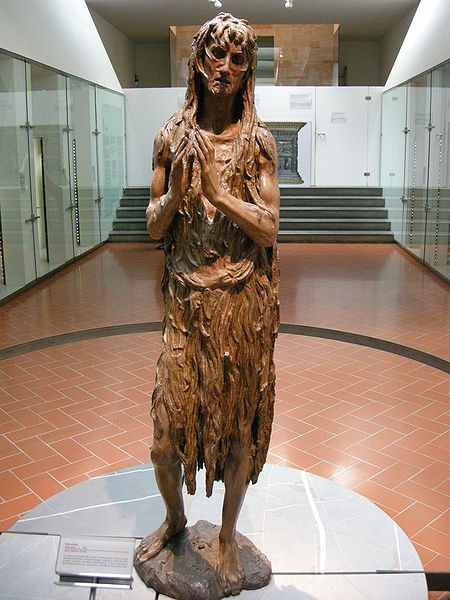
Donatello
La Maddalena
1455
Poplar wood with polychromy and gold
6’2” (1.88 m)
Museo dell’Opera del Duomo, Florence
Donatello made his harrowing Maddalena in the last decade of his life and the once beautiful Mary Magdalene he created was also at the end of hers. Her hands folded in prayer, she stands in a subtle contrapposto with her feet gripping the pedestal. Vasari describes her as “very beautiful and well executed, for she has wasted away by fasting and abstinence to such an extent that every part of her body reflects a perfect and complete understanding of human anatomy.” (Vasari, 149) She has been ravaged by time–thirty years of penitence in the wilderness–but she is not weak. Her body is sunken and cadaverous but for her muscular arms. Like many of Donatello’s subjects, she is more than just a beautiful figure; he truly created a character. Her internal drama and emotion has been drawn outward. Although she has chosen a life of penitence and suffering, one can still see the determination and defiance in her eyes. She stood this way in her home at Baptistry of San Giovanni for over 500 years, displayed on the floor at eye level.
When the waters of the Arno (not to mention the heating oil from Florence’s basements) came rushing through the Baptistry that morning in November five centuries later, the Maddalena’s lower half was immersed. By the time she was rescued, she had been heavily stained with oil and her thighs were cracked in two places, as though cleaved by a hatchet. That winter two young mud angels, John Schofield, a Brit, and Bruno Santi from nearby San Niccolò, were taken to see the Maddalena by Umberto Baldini, director of the Gabinetto del Restauro. In a far wing of the Palazzo Pitti, in a far corner of a dark, unheated room, she lay there on her back like a invalid. Most of the oil appeared to have been cleaned off, but she was still cracked; white paper had been placed underneath her to catch flakes of gesso, polychrome, and splinters, and her lower half wrapped in rice paper. (Clark, 222-223)
The Maddalena’s ending is a happy one. Her restoration, performed largely by sculptor Pelligrino Banella, would not simply return her to her pre-flood condition, but reveal her true nature from underneath the residue of chemicals and paints left by seventeenth and eighteenth century restorers. Thanks to the deep cleaning, she was revealed to be a polychrome, painted with many subtle colors, instead of a monochrome. Donatello used terra-cotta and flesh tones to give her leathery tan and added gilded streaks to her hair to enhance Mary Magdalene’s red hair. As wooden figures were sometimes carried through streets in processions, the golden streaks in her hair may have been added to reflect the sunlight. (Hartt, 298-299)
It is believed that she now looks closer to her original appearance than she has in centuries. In three years, she was ready for exhibition again. She now resides in the Museo dell’Opera del Duomo. Visitors can still look her in the eyes.
Works Cited
• Clark, R. (2008). Dark water: art, disaster, and redemption in Florence. New York: Anchor Books.
• Hartt, F, & Wilkins, D.G. (2009). History of Italian Renaissance art: painting, sculpture, architecture. Upper Saddle River, NJ: Prentice Hall.
• Vasari, G., Bondanella, J. C., & Bondanella, P. E. (1991). The lives of the artists. New York: Oxford University Press.

She’s a wonder to behold, and I’m very grateful for her rescue and restoration. One of the most gripping of works in a city of gripping works of art.